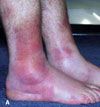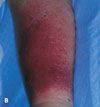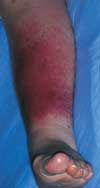Cellulitis--or Something Else?
Which of the rashes pictured here is cellulitis?



Which of the rashes pictured here is cellulitis?
A. Painful nodules and ankle edema in an older man.
B. Lower leg swelling and pain of 1 week's duration in a man who recently returned from Europe.
C. Red macules and a warm, swollen, painful ankle in a middle-aged woman.
(Answers on next page.)
Erythema Nodosum
A 65-year-old man presented with painful, bilateral erythematous nodules in the ankle region. The lesions had increased in size and number since they erupted 5 days earlier, and bilateral ankle edema had developed. The patient denied fever, chills, and recent infections. His history included hypertension, hyperlipidemia, and allergic rhinitis. His medications included extended-release nifedipine, 30 mg/d; atorvastatin, 10 mg/d; and fexofenadine, 60 mg bid.

A complete blood cell count ruled out leukocytosis. Chest films were normal; no evidence of sarcoidosis or tuberculosis was found. The erythrocyte sedimentation rate (ESR) was elevated. Because consecutive antistreptolysin O titers were negative, streptococcal infection was unlikely. Based on the clinical picture, erythema nodosum was diagnosed; no underlying cause was determined.
A review of the literature failed to find any evidence that this patient's medications caused erythema nodosum, so the regimen was continued. The lesions resolved in 6 weeks.
This inflammatory reaction pattern of the skin is characterized by painful, erythematous nodules that most often involve the anterior aspect of the lower legs. Lesions are predominantly distributed bilaterally in the pretibial region1; the ankles are frequently involved. Fever occurs in up to 50% of patients; ankle swelling, pharyngitis, and arthritis are also common.1 Erythema nodosum occurs predominantly in the winter and spring.2 The female-to-male ratio is 5:1.3
Common underlying causes include sarcoidosis; streptococcal infections; tuberculosis; fungal infections, such as coccidioidomycosis, blastomycosis, and histoplasmosis; viral infections, including hepatitis; lymphoma; inflammatory bowel disease; pregnancy; and medications.1-4 The underlying cause remains undetermined in as many as 55% of cases.3
The workup focuses on detecting the underlying cause, most commonly infection or sarcoidosis. Obtain a complete history that includes the patient's current medications and perform a thorough physical examination. Measure the ESR, which is always elevated in patients with erythema nodosum. Obtain a throat culture if exudate is noted on the tonsils. To exclude inflammatory bowel disease, question the patient about abdominal pain and diarrhea and test stool for occult blood. A chest film to rule out sarcoidosis or tuberculosis is warranted. Consecutive antistreptolysin O titers can confirm a streptococcal infection.
Consider all of your patient's medications as potential culprits. Although oral contraceptives and antibiotics are the most commonly implicated medications, erythema nodosum has also been associated with estrogen replacement therapy and omeprazole.5,6
Erythema nodosum is a self-limited disease that usually resolves within 4 to 8 weeks; however, residual lesions may persist for months. NSAIDs usually provide symptomatic relief. Systemic corticosteroids also are effective and may be used after underlying infections have been excluded. Potassium iodide is an old and effective treatment; its mechanism of action is unknown.
(Case and photograph courtesy of Bernard Karnath, MD.)
Streptococcal Cellulitis of the Leg
A 71-year-old man, who had recently returned from a month in Europe, complained of left lower leg swelling and pain of 1 week's duration. For many years, this obese patient had chronic venous insufficiency of both legs and chronic osteoarthritis of the knees that severely limited his ability to walk. The patient was admitted to the hospital with extensive cellulitis of the left lower leg.

Temperature was 39°C (102°F); blood pressure, 90/40 mm Hg; heart rate, 94 beats per minute; and urinary output, 10 mL per hour. A blood culture grew Streptococcus agalactiae, a group B species that was sensitive to most antibiotics tested. Intravenous cefazolin, dopamine, and intravenous fluids to maintain blood pressure and urine output were initiated. After 3 days, bullae developed over the entire left lower leg; complete superficial ulceration of the lower extremity followed.
The patient was transferred to a tertiary care facility, where hyperbaric oxygen therapy was added to the intravenous antibiotic therapy and general supportive care. He was released from the hospital after 1 month of treatment. Lower leg care-including soaks, compression stockings, and elevation-continued at home until the leg healed 6 weeks later.
(Case and photograph courtesy of Robert P. Blereau, MD.)
Leukocytoclastic Vasculitis
For the past 2 weeks, this 46-year-old woman had had malaise, myalgia, and hand and elbow arthralgia. Twelve hours before she was hospitalized, red spots started to appear on her shins and thighs. Soon afterward, her left ankle became increasingly painful, tender, and warm.

The patient's social history was unremarkable. She had never used intravenous drugs, and currently she was not sexually active. Her temperature was 38.5°C (101.3°F). The rash consisted of 3- to 5-mm macules, nonblanching and roughly circular, scattered mainly on the pretibial areas and the medial surface of her thighs. Her left ankle was warm, red, swollen, and painful with any joint motion.
On admission, ceftriaxone and vancomycin were administered empirically; these were discontinued 2 days later, when all microbiologic assays proved negative for pathologic organisms. Joint fluid and blood cultures were sterile. Pharyngeal, rectal, and uterine cervical cultures were negative for gonococcus, and serology for hepatitis B was unreactive. Skin biopsy on the second day of hospitalization confirmed the presence of leukocytoclastic vasculitis.
The patient was then given ibuprofen, and all her symptoms resolved. By the fourth day, she was able to walk freely, and her skin lesions had disappeared. She had had no recurrence 5 months after discharge and no longer required medication.
Leukocytoclastic (so called because of the apparent fragmentation of neutrophilic nuclei) vasculitis is a neutrophilic inflammation of small blood vessels. A number of disease processes, grouped collectively as "hypersensitivity vasculitis," cause this type of vessel inflammation, which predominantly affects the postcapillary venule.
Purpura, malaise, myalgia, and fever are the presenting symptoms of hypersensitivity vasculitis. Oligoarthritis or monarthritis is present in 40% of cases. Three diagnostic points are pertinent concerning the rash:
- The purpura is nonblanching; this indicates extravasation of blood from the inflamed postcapillary venules.
- The crops of circular purpura prefer dependent areas of the body; they are typically found on the legs, thighs, and buttocks in symmetric distribution.
- The shape of the individual macule is regular and approximately circular, because erythrocytes exude radially in all directions from the inflamed and damaged venules.
The last feature is in sharp contrast to arteritis, in which lesions have highly irregular margins that represent areas of skin infarction caused by vasculitic and thrombotic occulsion of the arterioles. Although Wegener granulomatosis, polyarteritis nodosa, Churg-Strauss syndrome, and some infections may cause palpable purpura, the macules caused by these disorders would typically have irregular margins, because they represent actual arteritic infarction rather than venular "ooze."
Leukocytoclastic vasculitis has a benign course because it is usually confined to the skin. It may, however, be closely mimicked by several serious diseases; eg, purpuric lesions and arthritis may appear in patients who have chronic hepatitis B infection, bacterial endocarditis, disseminated gonococcal infection, and meningococcemia.
Arthrocentesis should be done to rule out a joint infection in any patient with acute monarthritis. Because of the concern for meningococcemia and septic arthritis, empiric antibiotic therapy may be advisable until definitive data are available. Finally, even if the diagnosis of leukocytoclastic vasculitis is made, this may also be a feature of leukemia, lymphoma, systemic lupus erythematosus, rheumatoid arthritis, or Sjögren syndrome.
(Case and photograph courtesy of Scott D. Olewiler, MD.)